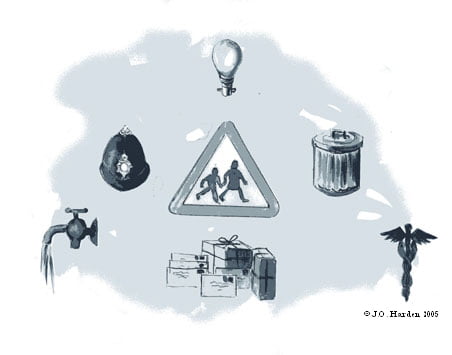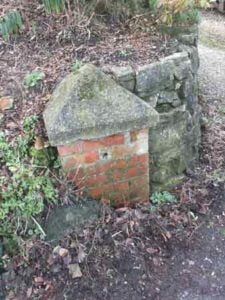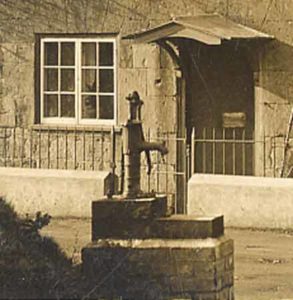
Utilities
The village is fortunate now in having water and electricity from a mains supply. These and other utility sevices only arrived in the twentieth century. Other provisions had to be made before then, as described below:
Water
 Before there was any concerted effort to provide the village with piped water, villagers relied on wells, or dipping, either from the stream, or from one of the many springs that are a feature of the village. Such a spring still runs down the side of Springfield in Mill Lane to a brick built ‘cistern’ close to the stream. This area was known as ‘the Dip’, so it was almost certainly a source of water for some people.
Before there was any concerted effort to provide the village with piped water, villagers relied on wells, or dipping, either from the stream, or from one of the many springs that are a feature of the village. Such a spring still runs down the side of Springfield in Mill Lane to a brick built ‘cistern’ close to the stream. This area was known as ‘the Dip’, so it was almost certainly a source of water for some people.
Running through the village, the stream provided a constant supply of water for any resident living close enough to benefit from such a convenient source. One of our older residents remembers how her father, using a yoke and two buckets, dipped water for the house from the stream in Back Street. Additionally, those houses in the High Street which were not adjacent to the stream bank had ‘dipping rights’, which permitted them to access the stream through land next to the gardens of the houses opposite.
Between 1922 and 1947 standpipes were installed in the village. Where this water came from and how far it stretched throughout the village is a subject for further research. As a child Ann Barnard (née Lee) remembers that although there was ‘a water tap against the wall of the Malt House … we pumped water into the kitchen of Southbank during the late 1940s’.
 There was a public pump at the point of the road where Brook Street converges with the A30.
There was a public pump at the point of the road where Brook Street converges with the A30.
 A deep bore hole was sunk in the garden of a cottage at East Farm to provide water for the 1914–18 military camps, but is unlikely to have extended its services beyond that immediate area. However, in 1947–48 Salisbury and Wilton Rural District Council took up the option of purchasing ministry pumping equipment. Whether this was material left behind after the demolition of the Fovant military camps is not known, but it seems highly likely, since the mains water system, which was laid throughout the village in 1948–50, took its water from the bore hole at East Farm.
A deep bore hole was sunk in the garden of a cottage at East Farm to provide water for the 1914–18 military camps, but is unlikely to have extended its services beyond that immediate area. However, in 1947–48 Salisbury and Wilton Rural District Council took up the option of purchasing ministry pumping equipment. Whether this was material left behind after the demolition of the Fovant military camps is not known, but it seems highly likely, since the mains water system, which was laid throughout the village in 1948–50, took its water from the bore hole at East Farm.
Electricity
Although electricity was established by the War Office for the 1914–18 camps, this was terminated when the camps were demolished. According to the Wessex Electricity Company, the eventual arrival of electricity in the village was a three-stage affair. The first area to benefit, in 1931, was the south of Fovant and the High Street, which at that time included Tisbury Road. The second stage, in the 1950s, covered the Church, Leatler Close and Dinton Road. The last instalment, in the late 1960s, connected Clay’s Orchard and Sling Orchard to the grid. Even a cursory reading of the areas mentioned show up notable exceptions to the Company’s supposed coverage.
Rubbish Disposal
Until the mid 1940s the disposal of household rubbish was something of a hit and miss affair. Much was just dumped in the pit of the unused quarry situated behind the Pembroke Arms, but some found its way into the woods, or was buried in a series of holes dug by the individual householder. It was not until after World War II, when the district council instigated the regular collection of household rubbish, that the village benefited from a more acceptable method of rubbish disposal.
Sewage
Until the mains water came to Fovant the process of sewage disposal fell into three rather primitive methods. Some households had septic tanks, which were emptied by private commercial arrangement, others had earth closets which no doubt had to change their venue at regular intervals; but for the most part the villagers used buckets. Twice a week the ‘night soil’ cart went through the village, emptying these receptacles and the accepted story is that the accumulated contents were deposited on a field opposite the Emblems Restaurant on the A30. Apparently there was always a bumper crop on that particular field. Eventually, during the late 1950s/early 1960s, a more hygienic drainage and sewage disposal scheme was installed throughout the village.
J.O.H.
2005
